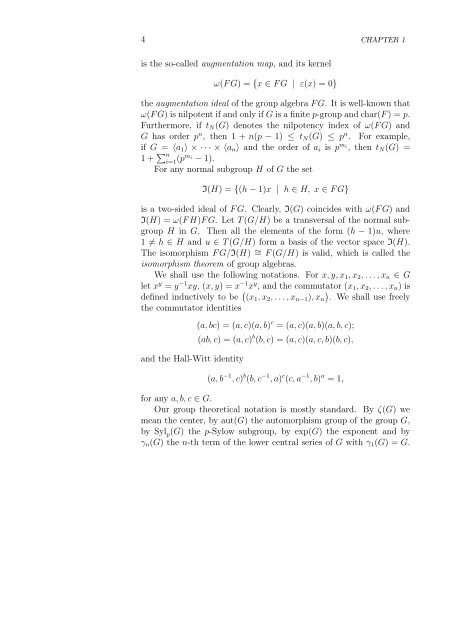On the Derived Length of Lie Solvable Group Algebras
On the Derived Length of Lie Solvable Group Algebras
On the Derived Length of Lie Solvable Group Algebras
You also want an ePaper? Increase the reach of your titles
YUMPU automatically turns print PDFs into web optimized ePapers that Google loves.
4 CHAPTER 1<br />
is <strong>the</strong> so-called augmentation map, and its kernel<br />
ω(F G) = {x ∈ F G | ε(x) = 0}<br />
<strong>the</strong> augmentation ideal <strong>of</strong> <strong>the</strong> group algebra F G. It is well-known that<br />
ω(F G) is nilpotent if and only if G is a finite p-group and char(F ) = p.<br />
Fur<strong>the</strong>rmore, if tN(G) denotes <strong>the</strong> nilpotency index <strong>of</strong> ω(F G) and<br />
G has order pn , <strong>the</strong>n 1 + n(p − 1) ≤ tN(G) ≤ pn . For example,<br />
if G = 〈a1〉 × · · · × 〈an〉 and <strong>the</strong> order <strong>of</strong> ai is pmi , <strong>the</strong>n tN(G) =<br />
1 + n i=1 (pmi − 1).<br />
For any normal subgroup H <strong>of</strong> G <strong>the</strong> set<br />
I(H) = {(h − 1)x | h ∈ H, x ∈ F G}<br />
is a two-sided ideal <strong>of</strong> F G. Clearly, I(G) coincides with ω(F G) and<br />
I(H) = ω(F H)F G. Let T (G/H) be a transversal <strong>of</strong> <strong>the</strong> normal subgroup<br />
H in G. Then all <strong>the</strong> elements <strong>of</strong> <strong>the</strong> form (h − 1)u, where<br />
1 = h ∈ H and u ∈ T (G/H) form a basis <strong>of</strong> <strong>the</strong> vector space I(H).<br />
The isomorphism F G/I(H) ∼ = F (G/H) is valid, which is called <strong>the</strong><br />
isomorphism <strong>the</strong>orem <strong>of</strong> group algebras.<br />
We shall use <strong>the</strong> following notations. For x, y, x1, x2, . . . , xn ∈ G<br />
let xy = y−1xy, (x, y) = x−1xy , and <strong>the</strong> commutator (x1, x2, . . . , xn) is<br />
defined inductively to be <br />
(x1, x2, . . . , xn−1), xn . We shall use freely<br />
<strong>the</strong> commutator identities<br />
and <strong>the</strong> Hall-Witt identity<br />
(a, bc) = (a, c)(a, b) c = (a, c)(a, b)(a, b, c);<br />
(ab, c) = (a, c) b (b, c) = (a, c)(a, c, b)(b, c),<br />
(a, b −1 , c) b (b, c −1 , a) c (c, a −1 , b) a = 1,<br />
for any a, b, c ∈ G.<br />
Our group <strong>the</strong>oretical notation is mostly standard. By ζ(G) we<br />
mean <strong>the</strong> center, by aut(G) <strong>the</strong> automorphism group <strong>of</strong> <strong>the</strong> group G,<br />
by Syl p(G) <strong>the</strong> p-Sylow subgroup, by exp(G) <strong>the</strong> exponent and by<br />
γn(G) <strong>the</strong> n-th term <strong>of</strong> <strong>the</strong> lower central series <strong>of</strong> G with γ1(G) = G.


